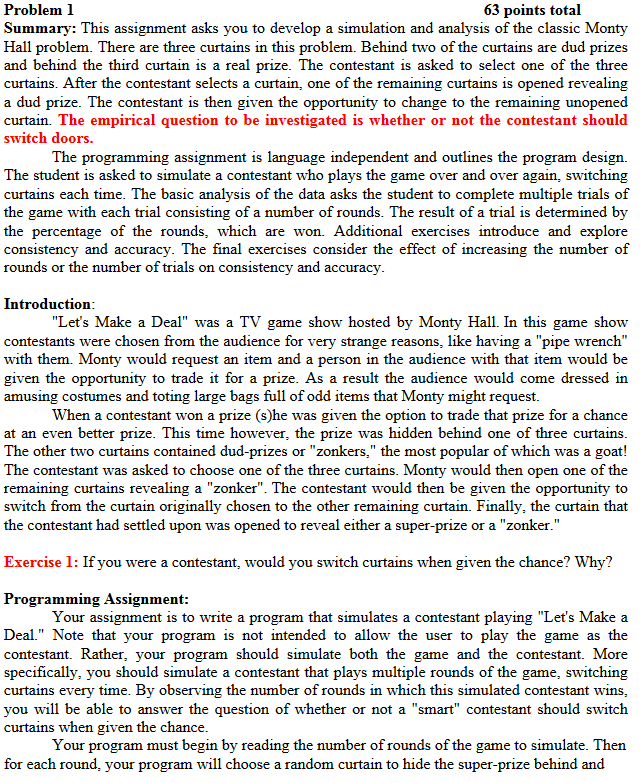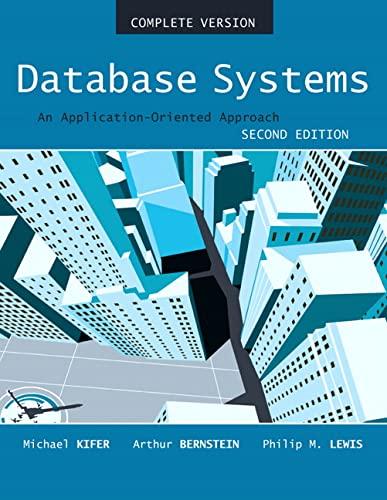

Problem 63 points total Summary: This assignment asks you to develop a simulation and analysis of the classic Monty Hall problem. There are three curtains in this problem. Behind two of the curtains are dud prizes and behind the third curtain is a real prize. The contestant is asked to select one of the three curtains. After the contestant selects a curtain, one of the remaining curtains is opened revealing a dud prize. The contestant is then given the opportunity to change to the remaining unopened curtain. The empirical question to be investigated is whether or not the contestant should switch doors The programming assignment is language independent and outlines the program design. The student is asked to simulate a contestant who plays the game over and over again, switching each time. The basic analysis of the data asks the student to complete multiple trials of the game with each trial consisting of a number of rounds. The result of a trial is determined by the percentage of the rounds, which are won. Additional exercises introduce and explore consistency and accuracy. The final exercises consider the effect of increasing the number of rounds or the number of trials on consistency and accuracy Introduction "Let's Make a Deal" was a TV game show hosted by Monty Hall. In this game show contestants were chosen from the audience for very strange reasons, like having a "pipe wrench with them. Monty would request an item and a person in the audience with that item would be given the opportunity to trade it for a prize. As a result the audience would come dressed in amusing costumes and toting large bags full of odd items that Monty might request When a contestant won a prize (s)he was given the option to trade that prize for a chance at an even better prize. This time however, the prize was hidden behind one of three curtains The other two curtains contained dud-prizes or "zonkers," the most popular of which was a goat! The contestant was asked to choose one of the three c urtains. Monty would then open one of the remaining curtains revealing a "zonker". The contestant would then be given the opportunity to switch from the curtain originally chosen to the other remaining curtain. Finally, the curtain that the contestant had settled upon was opened to reveal either a super-prize or a "z Exercise 1 If you were a contestant, would you switch curtains when given the chance? Why Programming Assignment Your assignment is to write a program that simulates a contestant playing "Let's Make a Deal." Note that your program is not intended to allow the user to play the game as the contestant. Rather, your program should simulate both the game and the contestant. More specifically, you should simulate a contestant that plays multiple rounds of the game, switching curtains every time. By observing the number of rounds in which this simulated contestant wins. you will be able to answer the question of whether or not a "smart" contestant should switch curtains when given the chance Your program must begin by reading the number of rounds of the game to simulate. Then for each round, your program will choose a random curtain to hide the super-prize behind and Problem 63 points total Summary: This assignment asks you to develop a simulation and analysis of the classic Monty Hall problem. There are three curtains in this problem. Behind two of the curtains are dud prizes and behind the third curtain is a real prize. The contestant is asked to select one of the three curtains. After the contestant selects a curtain, one of the remaining curtains is opened revealing a dud prize. The contestant is then given the opportunity to change to the remaining unopened curtain. The empirical question to be investigated is whether or not the contestant should switch doors The programming assignment is language independent and outlines the program design. The student is asked to simulate a contestant who plays the game over and over again, switching each time. The basic analysis of the data asks the student to complete multiple trials of the game with each trial consisting of a number of rounds. The result of a trial is determined by the percentage of the rounds, which are won. Additional exercises introduce and explore consistency and accuracy. The final exercises consider the effect of increasing the number of rounds or the number of trials on consistency and accuracy Introduction "Let's Make a Deal" was a TV game show hosted by Monty Hall. In this game show contestants were chosen from the audience for very strange reasons, like having a "pipe wrench with them. Monty would request an item and a person in the audience with that item would be given the opportunity to trade it for a prize. As a result the audience would come dressed in amusing costumes and toting large bags full of odd items that Monty might request When a contestant won a prize (s)he was given the option to trade that prize for a chance at an even better prize. This time however, the prize was hidden behind one of three curtains The other two curtains contained dud-prizes or "zonkers," the most popular of which was a goat! The contestant was asked to choose one of the three c urtains. Monty would then open one of the remaining curtains revealing a "zonker". The contestant would then be given the opportunity to switch from the curtain originally chosen to the other remaining curtain. Finally, the curtain that the contestant had settled upon was opened to reveal either a super-prize or a "z Exercise 1 If you were a contestant, would you switch curtains when given the chance? Why Programming Assignment Your assignment is to write a program that simulates a contestant playing "Let's Make a Deal." Note that your program is not intended to allow the user to play the game as the contestant. Rather, your program should simulate both the game and the contestant. More specifically, you should simulate a contestant that plays multiple rounds of the game, switching curtains every time. By observing the number of rounds in which this simulated contestant wins. you will be able to answer the question of whether or not a "smart" contestant should switch curtains when given the chance Your program must begin by reading the number of rounds of the game to simulate. Then for each round, your program will choose a random curtain to hide the super-prize behind and








